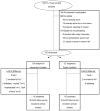Prime time: 18-month violence outcomes of a clinic-linked intervention
- PMID: 23543359
- PMCID: PMC3740021
- DOI: 10.1007/s11121-013-0387-5
Prime time: 18-month violence outcomes of a clinic-linked intervention
Abstract
Prime Time, a youth development intervention, aims to reduce multiple risk behaviors among adolescent girls seeking clinic services who are at high risk for pregnancy. The purpose of the current study was to examine whether Prime Time involvement produced changes in relational aggression, physical violence, and related psychosocial and behavioral outcomes. Qualitative case exemplars illustrated social contexts of intervention participants with differing longitudinal patterns of relational aggression and physical violence. Data were from a randomized efficacy trial with 13-17 year-old girls (n = 253) meeting specified risk criteria. Intervention participants were involved in Prime Time and usual clinic services for 18 months, control participants received usual clinic services. Participants in the current study completed self-report surveys at baseline and 18 months following enrollment. Outcomes analyses revealed significantly lower levels of relational aggression perpetration in the intervention group versus controls. In contrast, Prime Time involvement did not result in significant reductions in physical violence. Exploratory dose-response analyses indicated that reductions in relational aggression may have been most pronounced among girls actively involved in Prime Time case management and peer leadership activities. Qualitative findings suggested that the intervention's emphasis on modeling and building supportive relationships contributed to reductions in relational aggression. This study contributes to what has been a very limited evidence base regarding effective approaches to preventing violence among high-risk adolescent girls. Findings suggest that offering youth development interventions through clinic settings hold promise in reducing violence risk among vulnerable youth.
Figures
Similar articles
-
The impact of family and peer protective factors on girls' violence perpetration and victimization.J Adolesc Health. 2013 Mar;52(3):365-71. doi: 10.1016/j.jadohealth.2012.07.015. Epub 2012 Sep 27. J Adolesc Health. 2013. PMID: 23299002 Free PMC article.
-
Prime time: sexual health outcomes at 24 months for a clinic-linked intervention to prevent pregnancy risk behaviors.JAMA Pediatr. 2013 Apr;167(4):333-40. doi: 10.1001/jamapediatrics.2013.1089. JAMA Pediatr. 2013. PMID: 23440337 Free PMC article. Clinical Trial.
-
Prime Time: 12-month sexual health outcomes of a clinic-based intervention to prevent pregnancy risk behaviors.J Adolesc Health. 2011 Aug;49(2):172-9. doi: 10.1016/j.jadohealth.2010.12.002. Epub 2011 Mar 15. J Adolesc Health. 2011. PMID: 21783050 Free PMC article. Clinical Trial.
-
Relationships Between Mental Health, Skill Sets, and Violence Perpetration Among Adolescent Girls.J Interpers Violence. 2019 May;34(9):1801-1819. doi: 10.1177/0886260516657909. Epub 2016 Jul 3. J Interpers Violence. 2019. PMID: 27377563 Clinical Trial.
-
A concept analysis of relational aggression.J Psychiatr Ment Health Nurs. 2007 Aug;14(5):510-5. doi: 10.1111/j.1365-2850.2007.01120.x. J Psychiatr Ment Health Nurs. 2007. PMID: 17635260 Review.
Cited by
-
The impact of family and peer protective factors on girls' violence perpetration and victimization.J Adolesc Health. 2013 Mar;52(3):365-71. doi: 10.1016/j.jadohealth.2012.07.015. Epub 2012 Sep 27. J Adolesc Health. 2013. PMID: 23299002 Free PMC article.
-
Individual-, family-, and school-level interventions targeting multiple risk behaviours in young people.Cochrane Database Syst Rev. 2018 Oct 5;10(10):CD009927. doi: 10.1002/14651858.CD009927.pub2. Cochrane Database Syst Rev. 2018. PMID: 30288738 Free PMC article.
-
Systematic Review: Intervention Strategies for Treating Relational Aggression in Female Juvenile Offenders and At-Risk Female Youth.JAACAP Open. 2024 May 15;3(1):56-72. doi: 10.1016/j.jaacop.2024.04.003. eCollection 2025 Mar. JAACAP Open. 2024. PMID: 40109490 Free PMC article. Review.
-
Prime time: sexual health outcomes at 24 months for a clinic-linked intervention to prevent pregnancy risk behaviors.JAMA Pediatr. 2013 Apr;167(4):333-40. doi: 10.1001/jamapediatrics.2013.1089. JAMA Pediatr. 2013. PMID: 23440337 Free PMC article. Clinical Trial.
-
Prime Time: long-term sexual health outcomes of a clinic-linked intervention.Perspect Sex Reprod Health. 2014 Jun;46(2):91-100. doi: 10.1363/46e0914. Epub 2014 Mar 20. Perspect Sex Reprod Health. 2014. PMID: 24650164 Free PMC article. Clinical Trial.
References
-
- Ballinger G. Using generalized estimating equations for longitudinal data analysis. Organizational Research Methods. 2004;7:127–150.
-
- Bandura A. Social foundations of thought and action: A social cognitive theory. Englewood Cliffs, NJ: Prentice–Hall; 1986.
-
- Bar-On R. The Bar-On model of emotional-social intelligence. Psicothema. 2006;18(Suppl):13–25. - PubMed
-
- Birnbaum A, Lytle L, Story M, Perry C, Murray D. Are differences in exposure to a multicomponent school-based intervention associated with varying dietary outcomes in adolescents? Health Education Behavior. 2002;29:427–443. - PubMed
-
- Borowsky I, Ireland M, Resnick M. Violence risk and protective factors among youth held back in school. Ambulatory Pediatrics. 2002;2:475–484. - PubMed
Publication types
MeSH terms
Grants and funding
LinkOut - more resources
Full Text Sources
Other Literature Sources


